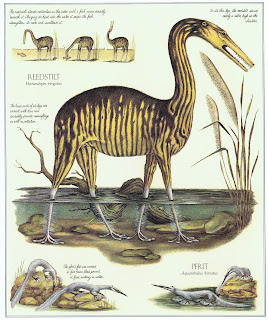Imaginary creatures aren't always pure fantasy. Sometimes the imagination can be grounded in science to come up with some interesting new ways to think about the amazing possibilities of life. Here are a few books and videos that do just that.
Myths and Monsters: Secrets Revealed, by Katie Edwards, illustrated by Simon Mendez - Each mythical creature featured in this book is paired with a real animal that may have spawned or contributed to the myth. The "realistic" illustrations of both imagined and actual creatures are colorful and quite beautiful. T really liked the animal pairings, some of which were new and surprising to her. P also gave this book a thumbs-up.
After Man, by Dougal Dixon - This book is written and illustrated in the style of an old-fashioned naturalist's notebook - picture Audubon, for example - but set on Earth 50 million years into the future when humans are gone from the scene and other animals have evolved in new and different directions. Extensive notes explain the underpinnings of evolution with which Dixon worked, keeping all his fantastic creatures firmly founded on actual scientific principles. (P liked the hornheads best. I like the rabbucks - after all, they look a lot like my favorite llamas and vicunas.)
Inspired by Dixon's book, there is a thirteen-part television documentary miniseries called The Future is Wild that imagines how life on Earth could evolve over 200 million years after the disappearance of humans. Each 25-minute episode focuses on a particular ecosystem at a particular time period, and profiles a few species and their interrelations within that ecosystem. It's based on science, but imagines entirely new creatures. We enjoyed it a lot, although P tended to take it a little personally when some member of his favorite species came to an untimely end. (And can I just say… octopuses taking the primates' place as most intelligent life on Earth is awesome!)
Expedition, by Wayne D. Barlowe - Another naturalist's notebook, this time from an A.D.2358 expedition to a planet called Darwin IV. Notable for making its alien species truly alien (no humanoids-with-funny-head-ridges here!), this book is a tour-de-force of imagination operating within the rules of science as we understand them. But it's not particularly intended for children, and P and T found it much too dense to be enjoyable. And I found that many of the creatures looked more like a Surrealist's nightmare than functioning life forms, which made it hard to get my head around. (It just goes to show that when you want to tell a story sometimes it doesn't pay to get too creative!)
However, inspired by Barlowe's book, there is a 94-minute television program called Alien Planet that shows a pair of robot probes exploring the life forms of Darwin IV. Perhaps because it had to reach a more general audience, this version focusses on the more accessible of Barlowe's creations, and also has a plot of sorts, in the journey and challenges faced by the two probes. P and T got quite attached to the probes as characters, but perhaps not so attached to the various hypothetical life forms. Still, it's a neat way to get sci-fi with a solid grounding in the way real scientists think.
[Pictures: Reedstilt and pfrit;
Wakka and strick, both illustrations by Dougal Dixon from After Man, 1981.]



No comments:
Post a Comment